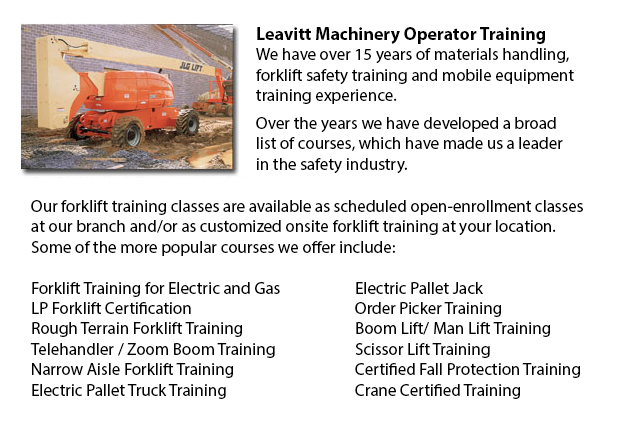
Kelowna Boom Lift Certification - Utilizing elevated work platforms allow for maintenance operations and work to be performed at elevated work heights that were otherwise unreachable. Workers making use of boom lifts and scissor lifts can be educated in how to safely operate these equipments by getting boom lift certification training.
When work platforms are operated unsafely, they have the potential for serious injury and even death, regardless of their lift style, site conditions or application. Electrocution, falls, crushed body parts, and tip-overs could be the terrible result of wrong operating procedures.
In order to avoid aerial lift incidents, people must be qualified in order to train workers in operating the certain kind of aerial lift they will be using. Controls should be easily accessible beside or in the platform of boom lifts utilized for carrying workers. Aerial lifts should never be modified without the express permission of other recognized entity or the manufacturer. If you are renting a lift, make certain that it is correctly maintained. Before utilizing, controls and safety devices must be checked to make certain they are working correctly.
Operational safety procedures are essential in avoiding accidents. Operators should not drive an aerial lift with the lift extended (even though some are designed to be driven with an extended lift). Always set brakes. Set outriggers, if available. Avoid slopes, but when needed utilize wheel chocks on slopes which do not go over the manufacturer's slope limitations. Follow weight and load restrictions of the manufacturer. When standing on the platform of boom lifts, make use of a safety belt with a two-foot lanyard tied to the boom or basket or a full-body harness. Fall protection is not necessary for scissor lifts which have guardrails. Never climb or sit on guardrails.
The boom lift certification course provides instruction in the following areas: training and certification; safety guidelines to prevent a tip-over; checking the work area and travel path; surface conditions and slopes; other guidelines for maintaining stability; stability factors; weight capacity; leverage; testing control functions; pre-operational check; mounting a motor vehicle; safe operating practices; power lines and overhead obstacles; safe driving procedures; making use of lanyards and harness; PPE and fall protection; and preventing falls from the platform.
When successful, the trained worker will learn the following: authorization and training procedures; pre-operational check procedures; how to prevent tip-overs; factors affecting the stability of scissor and boom lifts; how to use the testing control functions; how to utilize PPE and fall prevention strategies.
-
Kelowna Forklift Training Program
Kelowna Forklift Training Program - The lift truck is a common powered industrial vehicle which is in wide use these days. They are sometimes called hi los, lift trucks or jitneys. A departments store would use the forklift to unload and load merchan... More -
Kelowna Crane License
Kelowna Crane License - Crane operators ought to be "credentialed", that means they ought to have a crane operator certification or license. Credentialing is considered a mandatory governmental requirement in order to practice as an operator of a cra... More -
Kelowna Boom Lift Safety Training
Kelowna Boom Lift Safey Training - Boom lifts fall under the type of elevated work platform or aerial lifting device. Most usually used in warehousing, construction and industry; the boom lift is so versatile that it could be utilized in almost whate... More -
Kelowna Loader Training
Kelowna Loader Training - Loader Training - Any individual who would like to operate a forklift should take a Loader Training course in order to become a certified forklift truck operator. There are a variety of ways to obtain forklift training. Cour... More -
Kelowna Aerial Lift Safety Training
Kelowna Aerial Lift Safety Training - Each and every year, there are roughly 26 construction deaths attributed to the use of aerial lifts. Most of the craftsmen killed are electrical workers, laborers, painters, ironworkers or carpenters. The majorit... More -
Kelowna Crane Ticket
Kelowna Crane Ticket - Modern cranes can either be simple or complex, based upon the nature of the application they can carry out. For example, mobile cranes are somewhat simple units. A telescopic boom and even a steel truss mounts its movable platf... More -
Kelowna Boom Lift Operator Training
Kelowna Boom Lift Operator Training - The cherry picker work platform is a type of work platform, that will typically have a bucket or platform at the end of a hydraulic lifting system. The machine is likewise referred to as a man lift, boom lift, hy... More -
Kelowna Heavy Equipment Ticket
Kelowna Heavy Equipment Ticket - Depending on the nature of the job at hand, the kind of construction equipment that a heavy equipment operator makes use of differs. Every kind of machine is made to perform particular tasks in the most effective mann... More

Leavitt Operator Training
TOLL FREE: 1-888-254-6157
101-864 McCurdy Place
Kelowna, British Columbia
forkliftcertificationkelowna.com
Email Us
About Us


